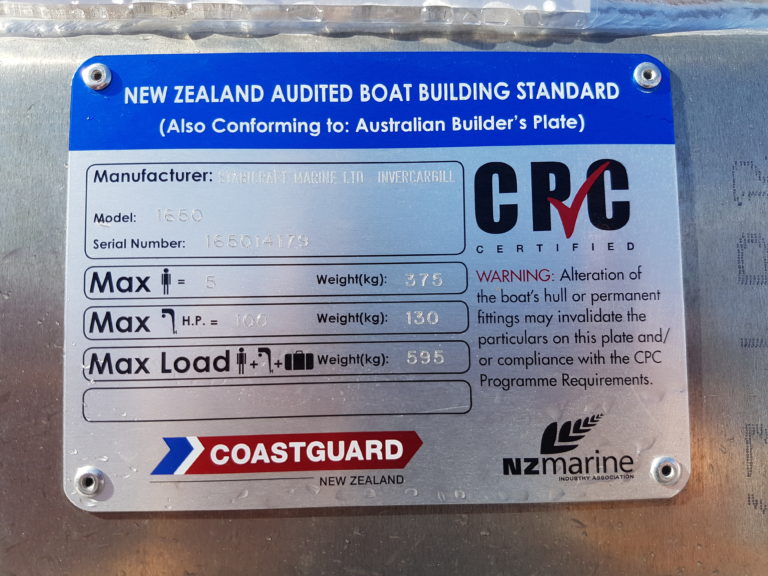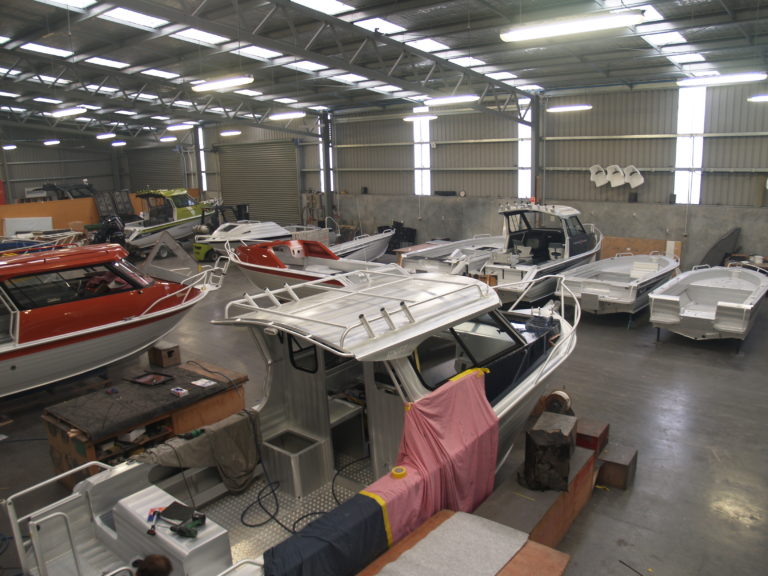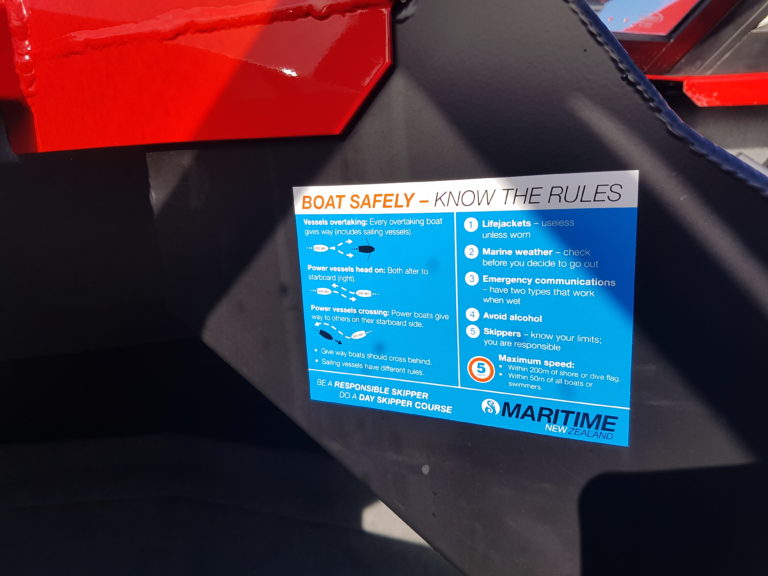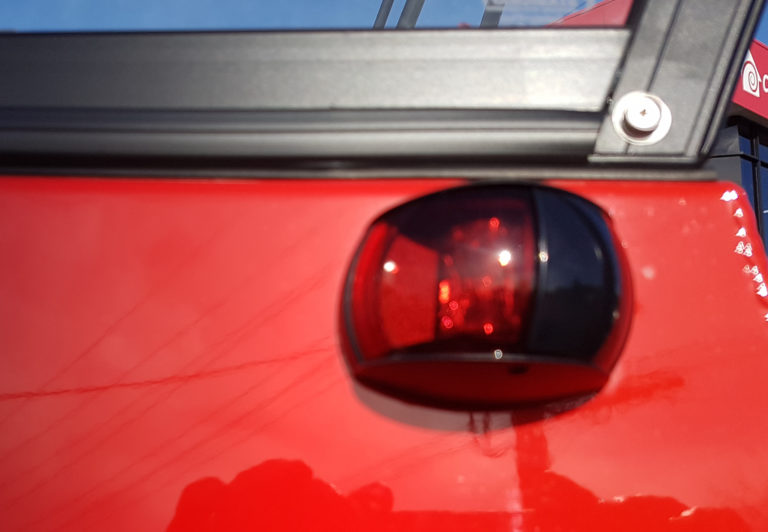You accept having to get a WOF for your car, so why not a boat? In New Zealand, the boating equivalent is known as CPC, (Compliance Programme Certified), a New Zealand audited boat building standard. While it is not mandatory for every boat manufacturer to build their boats to CPC standards, most of the leading builders in the country endorse the programme.
The NZ Boat Building Standard CPC is an NZ Marine Industry and Royal New Zealand Coastguard supported Marine Safety Programme for trailer power boats 3.5m – 8.5m in length. It is also recognised by the New Zealand Marine Safety Authority (NZ Government).
Readers who have been to boat shows, seen boat reviews in magazines or on TV, looked at dealer yards or checked out boat transoms at launching ramps may have seen an elegant aluminium plate bearing the letters CPC (Compliance Programme Certified.) The plate will include the Coastguard and NZ Marine logos and indicates that the boat is C.P.C. Certified.

It’s been 20 years since trailer boat manufacturers, the Boating Industries Association (now NZ Marine) and Coastguard joined forces to develop a programme that guarantees construction and safety standards for their boats.
Close to 25000 powered trailer boats from 3.5m to 8.5m now carry a CPC plate, certifying construction to specified engineering and safety standards that recognise the needs of safe boating in New Zealand waters.
There are now 14 manufacturers building CPC certified models, representing a broad cross section of fibreglass and aluminium builders, including most of the country’s leading brands, and the number is growing. There are also discussions with both polyethene and inflatable boat manufacturers to enter the programme in the future, once standards have been set. For a builder to join the CPC, there is a very stringent acceptance programme and minimum criteria must be met.

Griff Simpson, Chairman of the CPC Manufacturers Group, says that CPC is the only annually audited boat manufacturing standard in the world and it means that NZ boat builders in the recreational trailer boat market build to a standard that is checked on a regular basis by an independent surveyor.
“Buying a CPC approved model ensures consistency of construction and standards no matter what year it was built and owners know with certainty that the quality is maintained because the factory has been audited”, says Simpson.
Not only does the auditor check warranty claims, processes and all electrical and fuel standards, but also will pick a boat randomly off the production line to make sure that everything is still up to the approved CPC requirements.
Coastguard Approved
The code is now recognised as an independent measure of construction and safety standards for New Zealand-built boats and its development came at a time when there was no such assessment available to the boating public. The CPC programme owes its origins to discussions among industry members at the 1993 NZ Boat Show and their desire to offer the public products that are engineered and fitted out to recognised safety standards.

Fortunately, Coastguard considered the objective met its mandate and has shown strong support in developing and promoting the programme and its rules. All CPC technical standards require Coastguard approval and this illustrates the programme’s strong safety component.
The programme then needed a forum so interested manufacturers could get together with Coastguard, and this umbrella organisation was provided by NZ Marine. The three groups worked effectively together to develop a world-class programme that incorporates more than 200 years of manufacturer experience and draws on similar safety standards from the U.S. and Australia.
Independent Assesment
To benefit boat buyers, the standards each manufacturer has to meet are stringent and highly regulated. For a start, there is an Independent Composite or Structural Engineers Certification that ensures the fibreglass laminate of a fibreglass boat must be approved by an independent composite engineer or certification body. In the case of an aluminium boats, approval by a registered engineer or certification body is required.
All CPC audits in New Zealand are carried out by Robin Williams, (Robin Williams & Associates) an MNZ and AMSA accredited ship surveyor. Williams has been involved with the CPC from the very start and is a strong advocate of the programme.

“We firstly inspect every new model that a manufacturer wants to put into CPC and only if all requirements are meet, will it be given it a tick of approval”, says Williams.
He adds that over the past two decades he has seen a real commitment by manufacturers to maintain the highest standards and most go beyond what is
However, just because a particular model receives CPC approval, it isn’t something that it has forever. The manufacturer has to maintain records for each NZ Boat Building Standard CPC boat including production details, quality control report, who the boat was sold to and date of manufacture. They must also build/fit out the boat to meet programme requirements before a NZ Boat Building Standard CPC plate can be attached.
Requirements
Firstly, each boat must offer a minimum two-year structural hull warranty. This complements the manufacturer’s own, although most members currently offer a warranty exceeding two years. The programme details a number of construction standards for items added to the basic hull structure.
The manufacturer has to test and certify any new boat design over a 1km course in a practical on-the-water test. This ensures that the on-the-water performance is as important as the build quality.
The top portion of the C.P.C. plate contains two pieces of important information specific to each certified design, maximum adult loading capacity and maximum propeller shaft horsepower rating.
The maximum adult loading is based on an average weight of 75kg adult and is similar to the U.S. Coastguard formula. The maximum shaft HP rating also uses a formula similar to the U.S. Coastguard requirement. Fitting of a motor above this capacity means the boat does not comply with the NZ Boat Building Standard CPC.
The recommended minimum safety equipment is specified under two sections. First, a sticker – usually attached near the instrument panel – recommends the minimum safety equipment that should be carried onboard. Second, CPC specifies the equipment fitted such as navigation lights (to IMO standards) isolation switch, bilge pumps, fuel tanks and fuel delivery system to promote safe on the water performance.

The fuel system requirements apply to stern drive fixed fuel installations and fixed fuel installation for outboard motors. This includes tanks, system, support, level of tank contents, tank support, deck fill, tank venting, fuel line material, size of fuel line and installation.
“All individual components of the system have to be designed to withstand the combined conditions of pressure, vibration, shock and movement encountered in normal operating conditions”, says Williams.
One of the newest requirements is that vessels up to 6m must have enough positive buoyancy to stay afloat when swamped. This is provided with reserve buoyancy in the form of flotation material (closed cell plastics or equivalent) or air chambers sufficient to prevent the boat from sinking when swamped. This includes with all passengers clinging to it, in a condition of maximum load and person capacity, when fitted with the largest motor for which the boat is rated, and with all ancillary equipment and gear in their normal position.
The Compliance Code is helping to instil confidence for boat owners so we can have more enjoyment with our their time on the water, knowing that the boat we have is built to the highest safety standards.
CPC Approved Builders
Buccaneer Boats jenny@buccaneer.co.nz
CSB Huntsman info@csbhuntsmanboats.co.nz
Extreme Boats glenn@extremeboats.co.nz
Fi-Glass griff@mrboats.co.nz
Haines Hunter lionel@seacraft.co.nz
KiwiKraft Rodney@kiwikraft.co.nz
Marco Boats marco.boats@xtra.co.nz
McLay Boats stev@mclayboats.co.nz
Rayglass Boats dave@rayglass.co.nz
Reflex Products matthew@reflex.co.nz
Seaforce Marine info@seaforcemarine.co.nz
Smuggler Marine david@smuggler.co.nz
Stabicraft Marine sales@stabicraft.com
Tristram Marine lance@tristram.co.nz




